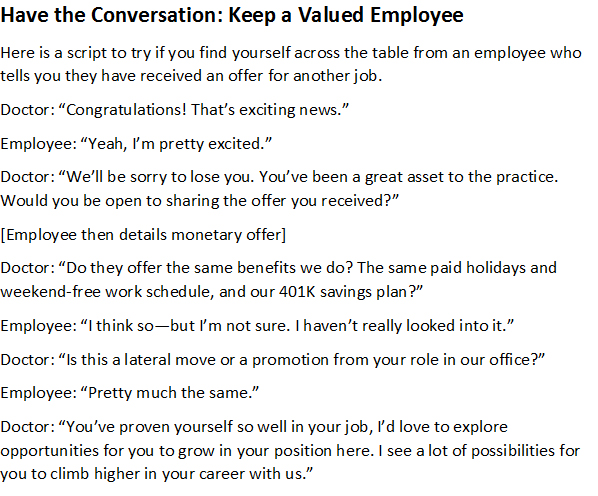By Casey Packer, OD

Oct. 4, 2017
If you’re lucky, all of your employees are star performers. If you’re somewhat lucky, at least a few are. You may not be the only one who knows how good they are. Former employers, or others, may try hiring them out from under you.
You can hold onto a valued employee–if you have an employee-retention strategy in place, and move quickly. That strategy should include a discussion of benefits and the expression of how much you appreciate the employee. Sometimes it’s not just about money; it’s about being appreciated, challenged and empowered.
Renegotiate & Motivate with Pay & Long-Term Growth
The first employee whom I almost lost was contacted by a previous employer. She had wanted to work for me because that former employer had under-paid her and treated her poorly. After I hired the employee, I expanded her skill-set, increasing her value both to me, and, as it turns out, others. I paid the employee to match the additional skills she acquired.
The previous office got in touch with the employee, and tried to outbid her current pay rate to get her back into their office. The employee brought this offer to me, and wanted to discuss it, because she said she would rather stay in my office. We negotiated a higher pay rate, thereby keeping her on staff.
Another employee was approached by a recruiter for an internet start-up company (not optically related). She was offered an entry-level position with full benefits. She also brought the offer to me to discuss. After discussing her future goals, we created a plan to move her into an office manager position, in which she has been fantastic.
The last employee was contacted by a headhunter hired by another group practice in the area. They contacted my optician and tried to hire her away with more money. Again, my employee came to me with the offer, and wanted to discuss it. However, there was bait-and-switch to their offer, in which the final offer turned out to be disappointing, and ultimately, I was able to increase the employee’s pay to maintain her employment.
 Prevent Poaching Attempts With Generous Benefits
Prevent Poaching Attempts With Generous Benefits
I learned that it is of paramount importance that you work toward offering a full panel of benefits to employees (401K matching program, insurance matching, profit sharing). It’s important to remember that the talented people you hire, and profit from, have many other opportunities in the job market. Your pay and benefits package needs to reflect that you understand that they can go elsewhere.
Create an Open-Door/Open-Dialog Culture
I never would have gotten the chance to keep my employees from leaving if they hadn’t felt comfortable enough with me to directly discuss the offers they had received.
If these employees hadn’t felt they were able to talk to me as both a respected friend, as well as an employer, they may not have felt secure enough to discuss with me. You always want to maintain a professional air with employees, but you never want them to feel that you are an authority figure they can’t share work-related struggles and aspirations with. When an employee joins the practice, it’s helpful to emphasize that you welcome ongoing conversations about their feelings working for your practice, and that you want to hear any suggestions they could offer on how you could help them do their job better, or be more happy at work.
It also helps to demonstrate in all your interactions with employees that you are the type of boss who has the patience to listen silently and then discuss in a helpful, how-about-this manner, rather than moving immediately into argument-and-debate mode. The productive, pleasant conversations my employees have had with me over the years led them to feel secure that if they explained the offers they had received, I could discuss it with them in a non-confrontational, non-argumentative, manner, and that I could even be helpful to them.
With that framework of trust laid, I was able to amicably talk through the offers they had received, and point out inconsistencies and downsides.
I learned that recruiters can be deceptive in their offers, or at least what they make their offers sound like. The headhunter who tried to snag my optician quoted crazy-high numbers initially, and then when my optician spoke with her potential new employer’s office manager about pay and benefits, she got a totally different story. If it sounds too good to be true, it probably is.
Set Goals With Employees: Show Them Long-Term Picture
It is helpful to set goals for employees, so they have something they are working toward. Rather than focusing solely on performance reviews, I like to talk in terms of goal-setting. It’s nice to have something to strive for, and look forward to.
For example, you might find that a back-office employee is interested in learning about opticianry, and eventually would like to move into a sales role, or you may find that an optician would like to transition to a supervisory role, such as office manager. It’s important to not just note the state of an employee’s work performance, but what their dream position in the practice would be, if it’s not the one they currently have.
I have set out goals for certain employees to move into management positions. They are aware of this, and it gives them something exciting to work toward.
Offer Help Achieving Certifications
Growth opportunities are only available commensurate with the growth of the practice. Until your practice gets to a certain size you may not be able to offer much growth other than financially. Certifications are a great way to motivate staff, and to offer more money for completion. I offer to reimburse staff for certification costs but only if they pass their testing. They are to pay for it upfront, and then will get reimbursed with an extra bonus once they show proof of passing.
Observe Level of Employee Engagement
Employee engagement is easy to observe–as long as you are paying attention to your practice. The practice owners who shift into cruise control, and act like bystanders, are the ones who won’t notice disengagement until it’s too late, and the best employees have left.
I like to explore new ways of improving our office, and I take a proactive role in discussing my ideas with staff, and hearing their ideas. We have weekly office meetings in which I have employees engage in learning activities and discussions.
I buy lunch for the whole staff during our weekly meetings, and we discuss challenges and examples of work well done from the previous week, along with new work systems we could implement, technologies we could be using better, and technology we may want to add to the office. Everyone is encouraged to speak freely with any idea they may have.
Encourage Learning Experiences Inside & Outside Your Office
I encourage shadowing to learn more about our profession in the offices of other healthcare practices we co-manage with and send patients to for consults. Employees whose minds are kept engaged with new information and experiences are less likely to become bored and restless. Encouraging employees to shadow in offices, such as that of eye surgeons, also benefits your own practice and patients, with employees able to better educate patients in what to expect when sent for a procedure like cataract surgery.
 Casey Packer, OD, is a certified optometric glaucoma specialist and therapeutic optometrist, and owner of Lone Star Eye, in Austin, Texas. To contact him: docpacker@gmail.com
Casey Packer, OD, is a certified optometric glaucoma specialist and therapeutic optometrist, and owner of Lone Star Eye, in Austin, Texas. To contact him: docpacker@gmail.com




























